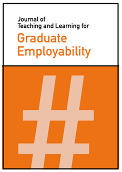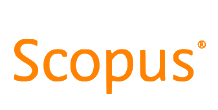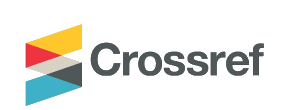Design thinking-learning and lifelong learning for employability in the 21st century
DOI:
https://doi.org/10.21153/jtlge2023vol14no1art1631Abstract
Surviving and thriving in this 21st century volatile, uncertain, complex, and ambiguous (VUCA) world caused by rapid digitalisation and changing work landscape, requires agile organisations with agile employees who are adaptable, resilient, and actively engaged in lifelong learning. A blended workforce encompassing full-time and 'gig' employees, working in tandem with smart machines, calls for an innovative and collaborative workforce capable of critical thinking and creative problem solving. This paper aims to highlight the potential of design thinking approaches to foster lifelong learning and graduate employability in a VUCA environment. The paper outlines an empirical study investigating the multiple benefits of incorporating design thinking process attributes in higher education. It argues that such processes can result in the development of 21st century skills and mindset and graduate capability themes that promote lifelong learning skills. Incorporating such strategies offers the potential to narrow the competency gap between workforce and work and enhance the employability and career development of graduates. The paper offers a Framework for Lifelong Learning in a VUCA environment that outlines the powerful traits that arise as payoffs from engaging in and practising design thinking. This framework can serve as a preliminary guide for higher education educators, learning organisations and individuals to inculcate and enhance lifelong learning
Metrics
References
Acemoglu, D., & Restrepo, P. (2018). The race between man and machine: Implications of technology for growth, factor shares, and employment. American Economic Review, 108(6), 1488-1542. https://doi.org/10.1257/aer.20160696
Bandura, A. (1994). Self - efficacy. In V. S. Ramachaudran (Ed), Encyclopedia of human behavior, 4, 71 - 81. https://www.academia.edu/32386167/Bandura_self_efficacy
Bandura, A. (2018). Toward a Psychology of Human Agency: Pathways and Reflections. Perspectives on Psychological Science, 13(2), 130 - 136. https://doi.org/10.1177/1745691617699280
Bass, R. (2018). The impact of Technology on the Future of Human Learning. Change: The Magazine of Higher Learning, 50(3-4), 34-39. https://doi.org/10.1080/00091383.2018.1507380
Berlyne, D. E. (1954). A theory of human curiosity. British Journal of Psychology, 45(3), 180 - 191. https://doi.org/10.1111/j.2044-8295.1954.tb01243.x
Bollington, A. (2015). Business Brief: Why isn't everyone lifelong learning? Organisation for Economic Cooperation and Development. https://www.oecd.org/education/lifelong-learning.htm
Brod, G., & Breitwieser, J. (2019). Lighting the wick in the candle of learning: generating a prediction stimulates curiosity. npj Science of Learning, 4, 1-7. https://doi.org/10.1038/s41539-019-0056-y
Bundtzen, H., & Hinrichs, G. (2021). The link between organizational agility and VUCA - An Agile Assessment Model. SocioEconomic Challenges, 5(1), 35-43. https://doi.org/https://doi.org/10.21272/sec.5(1).35-43.2021
Candy, P., Crebert, G., & O'Leary, J. (1994). Developing Lifelong Learners through Undergraduate Education. Australian Government Publishing Service. http://hdl.voced.edu.au/10707/94444
Carlgren, L., Elmquist, M., & Rauth, I. (2016). The challenges of using design thinking in industry-experiences from five large firms. Creativity and Innovation Management, 25(3), 344-362. https://doi.org/10.1111/caim.12176
Cook, E. J., Crane, L., Kinash, S., Bannatyne, A., Crawford, J., Hamlin, G., Judd, M.-M., Kelder, J.-A., Partridge, H., & Richardson, S. (2021). Australian postgraduate student experiences and anticipated employability: A national study from the students' perspective. The Journal of Teaching and Learning for Graduate Employability, 12(2), 148-168. https://ojs.deakin.edu.au/index.php/jtlge/article/view/1030/1156
Coorey, J., & Caldwell Rinnert, G. (2019). Design Thinking for Preschoolers: Encouraging Empathy through Play [Paper presentation] International Association of Societies of Design Research Conference, Manchester Metropolitan University, UK. https://iasdr2019.org/uploads/files/Proceedings/le-f-1157-Coo-J.pdf
Cousins, B. (2018). Design Thinking: Organizational Learning in VUCA Environments. Academy of Strategic Management Journal, 17(2), 1 - 18. https://www.abacademies.org/articles/design-thinking-organizational-learning-in-vuca-environments-7117.html
Creswell, J. (2020). Educational research: Planning, conducting, and evaluating quantitative and qualitative research (6th ed.). Pearson Higher Education.
Dall'Alba, G., & Barnacle, R. (2007). An ontological turn for higher education. Studies in Higher Education, 32(6), 679 - 692. https://doi.org/10.1080/03075070701685130
Duckworth, A. L., Peterson, C., Matthews, M. D., & Kelly, D. R. (2007). Grit: Perseverance and passion for long - term goals. Journal of Personality and Social Psychology, 92(6), 1087 - 1101. https://doi.org/10.1037/0022-3514.92.6.1087
Dweck, C. S. (2017). Mindset: Changing the way you think to fulfil your potential. (Updated Edition). Little, Brown Book Group. https://icrrd.com/media/01-11-2020-205951Mindset%20by%20Carol%20S.%20Dweck.pdf
Dweck, C. S., & Leggett, E. L. (1988). A Social - Cognitive Approach to Motivation and Personality. Psychological Review, 95(2), 256 - 273. https://doi.org/10.1037/0033-295X.95.2.256
Fulcher, K. H. (2008). Curiosity: A Link to Assessing Lifelong Learning. Assessment Update, 20(2), 5 - 7. https://doi.org/10.1002/au.202
Horstmeyer, A. (2019). How VUCA is changing the learning landscape - and how curiosity can help. Development and Learning in Organizations, 33(1), 5 - 8. https://doi.org/10.1108/DLO-09-2018-0119
Hsieh, H.-F., & Shannon, S. E. (2005). Three Approaches to Qualitative Content Analysis. Qualitative Health Research, 15(9), 1277 - 1288. https://doi.org/10.1177/1049732305276687
Hutchens, G. (2021, 5 April 2021). Job vacancies are surging, and employers say it's hard to find suitable labour. ABC. https://www.abc.net.au/news/2021-04-05/labour-shortages-hint-at-a-faster-economic-recovery/100047576
International Labour Organization. (2020). Report: Global Employment Trends for Youth 2020 - Technology and the future of jobs. https://www.ilo.org/wcmsp5/groups/public/---dgreports/---dcomm/---publ/documents/publication/wcms_737648.pdf
Jobst, B., Koppen, E., Lindberg, T., & Moritz, J. (2012). The Faith - Factor in Design Thinking: Creative Confidence Through Education at the Design Thinking Schools Potsdam and Stanford? In H. Plattner, C. Meinel, & L. Leifer (Eds.), Design Thinking Research Measuring Performance in Context (pp. 35 - 46). Springer Berlin Heidelberg. https://doi.org/10.1007/978-3-642-31991-4_3
Jordan, M. E., Kleinsasser, R. C., & Roe, M. F. (2014). Wicked Problems: inescapable wickedity. Journal of Education for Teaching, 40(4), 415 - 430. https://doi.org/10.1080/02607476.2014.929381
Kelley, T., & Kelley, D. (2012, December 2012). Reclaim your Creative Confidence. Harvard Business Review, 95(12), 115 - 118. https://hbr.org/2012/12/reclaim-your-creative-confidence
Lauff, C., Schwartz, D. K.-., & Rentschler, M. E. (2018). What is a Prototype? What are the Roles of Prototypes in Companies? Journal of Mechanical Design, 140(6), 1 – 12. https://doi.org/10.1115/1.4039340
Lawson, M. J., Askell - Williams, H., & Murray - Harvey, R. (2006). Report: The Attributes of the Lifelong Learner. Queensland Studies Authority, Australia. https://www.qcaa.qld.edu.au/downloads/publications/research_qsa_lifelong_learner.pdf
LeBlanc, P. J. (2018). Higher Education in a VUCA World. Change: The Magazine of Higher Learning, 50(3 - 4), 23 - 26. https://doi.org/10.1080/00091383.2018.1507370
Liedtka, J. (2018, 1 September 2018). Why Design Thinking Works. Harvard Business Review, 95(5), 72. https://hbr.org/2018/09/why-design-thinking-works
Lindberg, T., Gumienny, R., Jobst, B., & Meinel, C. (2010). Is There a Need for a Design Thinking Process? [Paper presentation]. Design Thinking Research Symposium 8 (Design 2010), Sydney, Australia. https://hpi.de/fileadmin/user_upload/fachgebiete/meinel/papers/Design_Thinking/2010_Lindberg_Design.pdf
Manpower Group. (2018). Report: Solving the Talent Shortage: Build, Buy, Borrow and Bridge. https://go.manpowergroup.com/hubfs/TalentShortage%202018%20(Global)%20Assets/PDFs/MG_TalentShortage2018_lo%206_25_18_FINAL.pdf
Matthews, K. E., Divan, A., John-Thomas, N., Lopes, V., Ludwig, L. O., Martini, T. S., Motley, P., & Tomljenovic-Berube, A. M. (2013). SoTL and Students' Experiences of their Degree - Level Programs: An Empirical Investigation. Teaching and Learning Inquiry: The ISSOTL Journal, 1(2), 75 - 89. https://doi.org/10.2979/teachlearninqu.1.2.75
McKenzie, S., Coldwell-Nelson, J., & Palmer, S. (2021). Integrating career development into an undergraduate IT curriculum at an Australian University. Education and Information Technologies, 26, 5971-5990. https://doi.org/10.1007/s10639-021-10567-3
McLaughlin, J. E., Chen, E., Lake, D., Guo, W., Skywark, E. R., Chernik, A., & Liu, T. (2022). Design thinking teaching and learning in higher education: Experiences across four universities. PLOS ONE, 17(3), 1-16. https://doi.org/10.1371/journal.pone.0265902
Melles, G. (2020). Introduction: Design thinking - Tensions and opportunities. In M. Gavin (Ed.), Design Thinking in Higher Education - Interdisciplinary Encounters (pp. 1-6). Springer. https://doi.org/10.1007/978-981-15-5780-4_1
Merck KGaA. (2016). Report: Be Curious: State of Curiosity. Merck KGaA, Group Communications. https://www.emdgroup.com/company/us/curiosity-full-report-us.pdf
Mrazek, A. J., Ihm, E. D., Molden, D. C., Michael D, M., Zedelius, C. M., & Schooler, J. W. (2018). Expanding minds: Growth mindsets of self - regulation and the influences on effort and perseverance. Journal of Experimental Social Psychology, 79, 164 - 180. https://doi.org/10.1016/j.jesp.2018.07.003
Mwaikokesya, M. J. D., Osborne, M., & Houston, M. (2014). Mapping Lifelong Learning Attributes in the Context of Higher Education Institutions. Journal of Adult and Continuing Education 20(2), 21 - 36. https://doi.org/10.7227/JACE.20.2.3
Nardo, M., Forino, D., & Murino, T. (2020). The evolution of man-machine interaction: the role of human in industry 4.0 paradigm. Production & Manufacturing Research, 8(1), 20-34. https://doi.org/10.1080/21693277.2020.1737592
Ng, B. (2018). The Neuroscience of Growth Mindset and Intrinsic Motivation. Brain Science, 8(2: 20), 1 - 10. https://doi.org/10.3390/brainsci8020020
Organisation for Economic Cooperation and Development (2001). Education Policy Analysis 2001: Lifelong learning for all: Policy Directions. Centre for Educational Research and Innovation. https://doi.org/10.1787/epa-2001-en
Orr, D., Luebcke, M., Schmidt, J. P., Ebner, M., & Wannemacher, K. (2020). Higher Education Landscape 2030; A trend analysis based on the AHEAD International Horizon Scanning. Springer, Cham. https://doi.org/10.1007/978-3-030-44897-4
Osborne, M. S., McPherson, G. E., Miksza, P., & Evans, P. (2021). Using a microanalysis intervention to examine shifts in musicians' self-regulated learning. Psychology of Music, 49(4), 972-988. https://doi.org/10.1177/0305735620915265
Pande, M., & Bharathi, S. V. (2020). Theoretical foundations of design thinking - A constructivism learning approach to design thinking. Thinkings Skills and Creativity, 36, 1-17. https://doi.org/10.1016/j.tsc.2020.100637
Panke, S. (2019). Design thinking in education: Perspectives, Opportunities and Challenges. Open Education Studies, 1(1), 281-306. https://doi.org/10.1515/edu-2019-0022
Pavey, L., Greitemeyer, T., & Sparks, P. (2012). "I Help Because I Want to, Not Because You Tell Me to": Empathy Increases Autonomously Motivated Helping. Personality and Social Psychology Bulletin, 38(5), 681 - 689. https://doi.org/10.1177/0146167211435940
Radovic, S., Hummel, H. G. K., & Vermeulen, M. (2021). The mARC instructional design model for more experential learnimng in higher education: theoretical foundations and practical guidelines. Teaching in Higher Education, 1-18. https://doi.org/https://doi.org/10.1080/13562517.2021.1872527
Rae, J. (2016). Design Value Index Exemplars Outperform the S&P 500 Index (Again) and a New Crop of Design Leaders Emerge. Design Management Institute, 27(4), 4 – 11. https://onlinelibrary.wiley.com/doi/abs/10.1111/drev.12040
Reiter-Palmon, R., & Leone, S. (2019). Facilitating creativity in interdisciplinary design teams using cognitive processes: A review. Proceedings of the Institution of Mechanical Engineers, Part C: Journal of Mechanical Engineering Science, 233(2), 385 - 394. https://doi.org/10.1177/0954406217753236
Richards, J., & Dede, C. (2020, 20 October 2020). The 60 - year Curriculum: A Strategic Response to a Crisis. Educause Review, 4, 25 - 38. https://er.educause.edu/-/media/files/articles/2020/10/er20_4102.pdf
Rios, J. A., Ling, G., Pugh, R., Becker, D., & Bacall, A. (2020). Identifying Critical 21st - Century Skills for Workplace Success: A content Analysis of Job Advertisements. Educational Researcher, 49(2), 80 - 89. https://doi.org/10.3102/0013189X19890600
Ryan, R. M., & Deci, E. L. (2000). Self - determination theory and the facilitation of intrinsic motivation, social development, and well-being. American Psychologist, 55(1), 68 - 68. https://doi.org/10.1037/0003-066X.55.1.68
Ryan, R. M., & Deci, E. L. (2017). Self-determination theory: Basic psychological needs in motivation, development, and wellness. The Guilford Press. https://doi.org/10.1521/978.14625/28806
Seevaratnam, V. (2022). Design thinking-learning and its impact on students' learning for the 21st century [MPhil, The University of Queensland]. Australia. https://espace.library.uq.edu.au/view/UQ:080199a
Tai, J., Ajjawi, R., Boud, D., Dawson, P., & Panadero, E. (2018). Developing evaluative judgement: enabling students to make decisions about the quality of work. Higher Education, 76, 467 - 481. https://doi.org/10.1007/s10734-017-0220-3
The Foundation for Young Australians. (2018). FYA's New Work Order Report Series: The New Work Reality. https://www.fya.org.au/app/uploads/2021/09/TheNewWorkReality_2018.pdf
The Foundation for Young Australians. (2020). FYA's New Work Order Report Series: The New Work Standard - How Young People Are Engaging with Flexible Work. https://www.fya.org.au/app/uploads/2021/09/FYA-New-Work-Standard-2020.pdf
The Stanford d.school. (n.d.). An Introduction to Design Thinking: Process Guide. Hasso Plattner Institute of Design at Stanford. https://web.stanford.edu/~mshanks/MichaelShanks/files/509554.pdf
Tschepe, S. (2018, 21 June 2018). How Design Thinking can benefit Education. https://www.linkedin.com/pulse/how-design-thinking-can-benefit-education-samuel-tschepe/
Vallas, S., & Schor, J. B. (2020). What do platforms do? Understanding the gig economy. Annual Review of Sociology, 46, 273-294. https://doi.org/10.1146/annurev-soc-121919-054857
Von Thienen, J., Royalty, A., & Meinel, C. (2017). Design Thinking in Higher Education : How students become Dedicated Creative Problem Solvers. In C. Zhou (Ed.), Handbook of Research on Creative Problem - Solving Skill Development in Higher Education (pp. 306 - 328). IGI Global. https://doi.org/10.4018/978-1-5225-0643-0.ch014
Wade, S., & Kidd, C. (2019). The role of prior knowledge and curiosity in learning. Psychonomic Bulletin & Review, 26, 1377 - 1387. https://doi.org/10.3758/s13423-019-01598-6
World Economic Forum. (2022). Report: Catalysing Education 4.0: Investing in the Future of Learning for a Human-Centric Recovery. World Economic Forum. https://www3.weforum.org/docs/WEF_Catalysing_Education_4.0_2022.pdf
Wright, N., & Wrigley, C. (2019). Broadening design - led education horizons: conceptual insights and future research directions. International Journal of Technology and Design Education, 29, 1 - 23. https://doi.org/10.1007/s10798-017-9429-9
Zaber, M. A., Karoly, L. A., & Whipkey, K. (2019). Report: Reimagining the Workforce Development and Employment System for the 21st Century and Beyond. Rand Corporation. https://www.rand.org/content/dam/rand/pubs/research_reports/RR2700/RR2768/RAND_RR2768.pdf
Zaki, J. (2019, 30 May 2019). Making Empathy Central to Your Company Culture. Harvard Business Review. https://hbr.org/2019/05/making-empathy-central-to-your-company-culture
Zimmermann, B. J. (1990). Self - Regulated Learning and Academic Achievement: An Overview. Educational Psychologist, 25(1), 3 - 17. https://doi.org/10.1207/s15326985ep2501_2
Downloads
Published
Issue
Section
License
Copyright (c) 2023 Vijayakumari Seevaratnam, Deanne Gannaway, Jason Lodge

This work is licensed under a Creative Commons Attribution-NonCommercial 4.0 International License.












